2022 CHEVROLET BOLT EV winter tires
[x] Cancel search: winter tiresPage 162 of 316
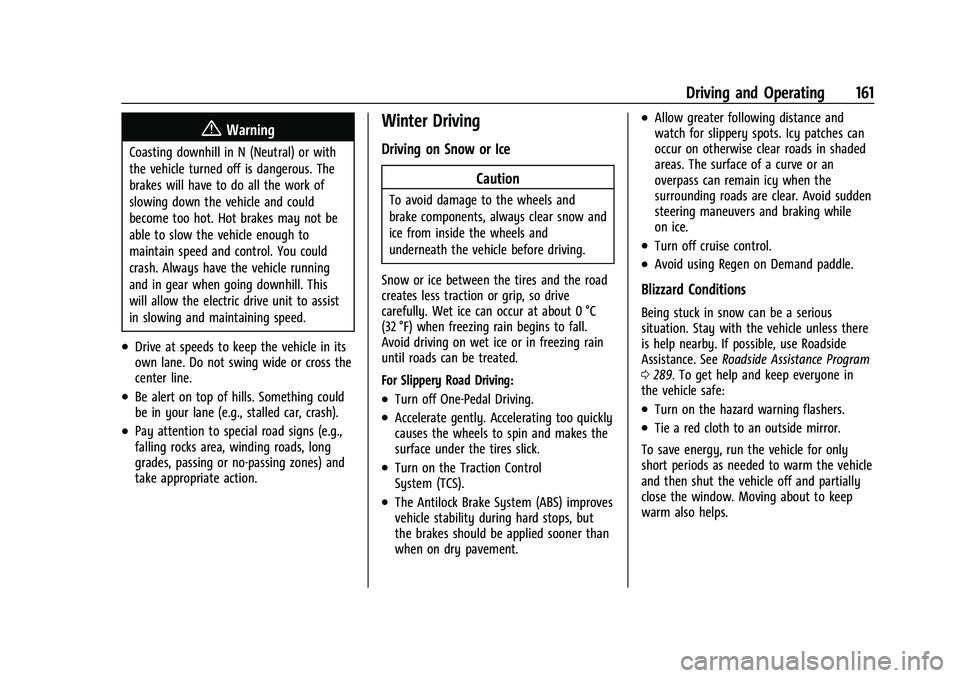
Chevrolet BOLT EV Owner Manual (GMNA-Localizing-U.S./Canada-
15082216) - 2022 - CRC - 6/25/21
Driving and Operating 161
{Warning
Coasting downhill in N (Neutral) or with
the vehicle turned off is dangerous. The
brakes will have to do all the work of
slowing down the vehicle and could
become too hot. Hot brakes may not be
able to slow the vehicle enough to
maintain speed and control. You could
crash. Always have the vehicle running
and in gear when going downhill. This
will allow the electric drive unit to assist
in slowing and maintaining speed.
.Drive at speeds to keep the vehicle in its
own lane. Do not swing wide or cross the
center line.
.Be alert on top of hills. Something could
be in your lane (e.g., stalled car, crash).
.Pay attention to special road signs (e.g.,
falling rocks area, winding roads, long
grades, passing or no-passing zones) and
take appropriate action.
Winter Driving
Driving on Snow or IceCaution
To avoid damage to the wheels and
brake components, always clear snow and
ice from inside the wheels and
underneath the vehicle before driving.
Snow or ice between the tires and the road
creates less traction or grip, so drive
carefully. Wet ice can occur at about 0 °C
(32 °F) when freezing rain begins to fall.
Avoid driving on wet ice or in freezing rain
until roads can be treated.
For Slippery Road Driving:
.Turn off One-Pedal Driving.
.Accelerate gently. Accelerating too quickly
causes the wheels to spin and makes the
surface under the tires slick.
.Turn on the Traction Control
System (TCS).
.The Antilock Brake System (ABS) improves
vehicle stability during hard stops, but
the brakes should be applied sooner than
when on dry pavement.
.Allow greater following distance and
watch for slippery spots. Icy patches can
occur on otherwise clear roads in shaded
areas. The surface of a curve or an
overpass can remain icy when the
surrounding roads are clear. Avoid sudden
steering maneuvers and braking while
on ice.
.Turn off cruise control.
.Avoid using Regen on Demand paddle.
Blizzard Conditions
Being stuck in snow can be a serious
situation. Stay with the vehicle unless there
is help nearby. If possible, use Roadside
Assistance. See Roadside Assistance Program
0 289. To get help and keep everyone in
the vehicle safe:
.Turn on the hazard warning flashers.
.Tie a red cloth to an outside mirror.
To save energy, run the vehicle for only
short periods as needed to warm the vehicle
and then shut the vehicle off and partially
close the window. Moving about to keep
warm also helps.
Page 217 of 316
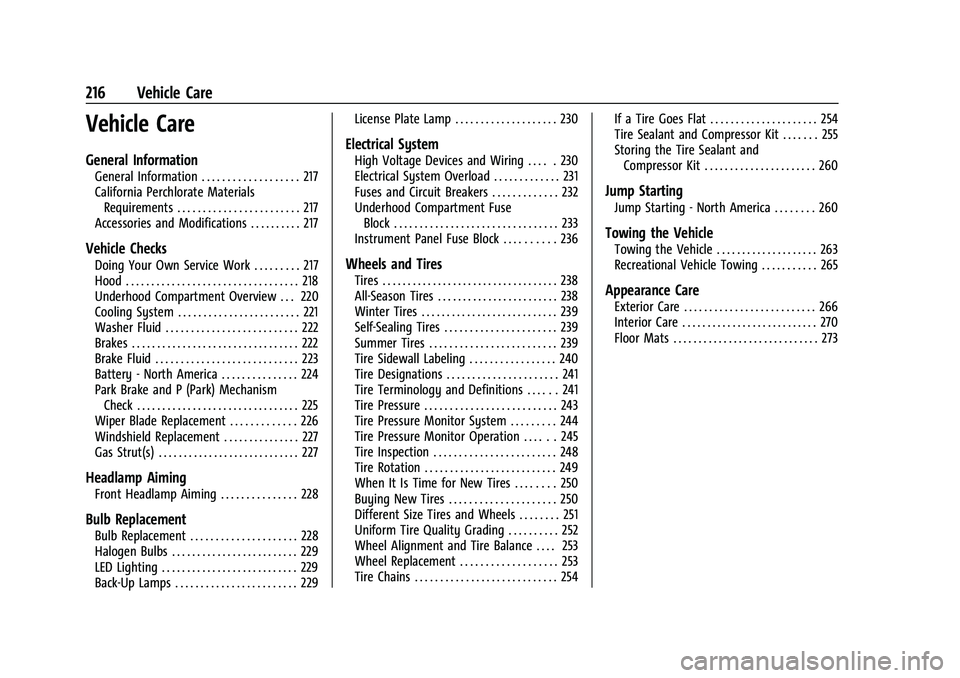
Chevrolet BOLT EV Owner Manual (GMNA-Localizing-U.S./Canada-
15082216) - 2022 - CRC - 6/25/21
216 Vehicle Care
Vehicle Care
General Information
General Information . . . . . . . . . . . . . . . . . . . 217
California Perchlorate MaterialsRequirements . . . . . . . . . . . . . . . . . . . . . . . . 217
Accessories and Modifications . . . . . . . . . . 217
Vehicle Checks
Doing Your Own Service Work . . . . . . . . . 217
Hood . . . . . . . . . . . . . . . . . . . . . . . . . . . . . . . . . . 218
Underhood Compartment Overview . . . 220
Cooling System . . . . . . . . . . . . . . . . . . . . . . . . 221
Washer Fluid . . . . . . . . . . . . . . . . . . . . . . . . . . 222
Brakes . . . . . . . . . . . . . . . . . . . . . . . . . . . . . . . . . 222
Brake Fluid . . . . . . . . . . . . . . . . . . . . . . . . . . . . 223
Battery - North America . . . . . . . . . . . . . . . 224
Park Brake and P (Park) Mechanism Check . . . . . . . . . . . . . . . . . . . . . . . . . . . . . . . . 225
Wiper Blade Replacement . . . . . . . . . . . . . 226
Windshield Replacement . . . . . . . . . . . . . . . 227
Gas Strut(s) . . . . . . . . . . . . . . . . . . . . . . . . . . . . 227
Headlamp Aiming
Front Headlamp Aiming . . . . . . . . . . . . . . . 228
Bulb Replacement
Bulb Replacement . . . . . . . . . . . . . . . . . . . . . 228
Halogen Bulbs . . . . . . . . . . . . . . . . . . . . . . . . . 229
LED Lighting . . . . . . . . . . . . . . . . . . . . . . . . . . . 229
Back-Up Lamps . . . . . . . . . . . . . . . . . . . . . . . . 229 License Plate Lamp . . . . . . . . . . . . . . . . . . . . 230
Electrical System
High Voltage Devices and Wiring . . . . . 230
Electrical System Overload . . . . . . . . . . . . . 231
Fuses and Circuit Breakers . . . . . . . . . . . . . 232
Underhood Compartment Fuse
Block . . . . . . . . . . . . . . . . . . . . . . . . . . . . . . . . 233
Instrument Panel Fuse Block . . . . . . . . . . 236
Wheels and Tires
Tires . . . . . . . . . . . . . . . . . . . . . . . . . . . . . . . . . . . 238
All-Season Tires . . . . . . . . . . . . . . . . . . . . . . . . 238
Winter Tires . . . . . . . . . . . . . . . . . . . . . . . . . . . 239
Self-Sealing Tires . . . . . . . . . . . . . . . . . . . . . . 239
Summer Tires . . . . . . . . . . . . . . . . . . . . . . . . . 239
Tire Sidewall Labeling . . . . . . . . . . . . . . . . . 240
Tire Designations . . . . . . . . . . . . . . . . . . . . . . 241
Tire Terminology and Definitions . . . . . . 241
Tire Pressure . . . . . . . . . . . . . . . . . . . . . . . . . . 243
Tire Pressure Monitor System . . . . . . . . . 244
Tire Pressure Monitor Operation . . . . . . 245
Tire Inspection . . . . . . . . . . . . . . . . . . . . . . . . 248
Tire Rotation . . . . . . . . . . . . . . . . . . . . . . . . . . 249
When It Is Time for New Tires . . . . . . . . 250
Buying New Tires . . . . . . . . . . . . . . . . . . . . . 250
Different Size Tires and Wheels . . . . . . . . 251
Uniform Tire Quality Grading . . . . . . . . . . 252
Wheel Alignment and Tire Balance . . . . 253
Wheel Replacement . . . . . . . . . . . . . . . . . . . 253
Tire Chains . . . . . . . . . . . . . . . . . . . . . . . . . . . . 254 If a Tire Goes Flat . . . . . . . . . . . . . . . . . . . . . 254
Tire Sealant and Compressor Kit . . . . . . . 255
Storing the Tire Sealant and
Compressor Kit . . . . . . . . . . . . . . . . . . . . . . 260
Jump Starting
Jump Starting - North America . . . . . . . . 260
Towing the Vehicle
Towing the Vehicle . . . . . . . . . . . . . . . . . . . . 263
Recreational Vehicle Towing . . . . . . . . . . . 265
Appearance Care
Exterior Care . . . . . . . . . . . . . . . . . . . . . . . . . . 266
Interior Care . . . . . . . . . . . . . . . . . . . . . . . . . . . 270
Floor Mats . . . . . . . . . . . . . . . . . . . . . . . . . . . . . 273
Page 240 of 316

Chevrolet BOLT EV Owner Manual (GMNA-Localizing-U.S./Canada-
15082216) - 2022 - CRC - 6/25/21
Vehicle Care 239
equipment all-season tires can be identified
by the last two characters of this TPC code,
which will be“MS.”
Consider installing winter tires on the
vehicle if frequent driving on snow or
ice-covered roads is expected. All-season tires
provide adequate performance for most
winter driving conditions, but they may not
offer the same level of traction or
performance as winter tires on snow or
ice-covered roads. See Winter Tires0239.
Winter Tires
This vehicle was not originally equipped
with winter tires. Winter tires are designed
for increased traction on snow and
ice-covered roads. Consider installing winter
tires on the vehicle if frequent driving on ice
or snow covered roads is expected. See your
dealer for details regarding winter tire
availability and proper tire selection. Also,
see Buying New Tires 0250.
With winter tires, there may be decreased
dry road traction, increased road noise, and
shorter tread life. After changing to winter
tires, be alert for changes in vehicle
handling and braking. If using winter tires:
.Use tires of the same brand and tread
type on all four wheel positions.
.Use only radial ply tires of the same size,
load range, and speed rating as the
original equipment tires.
Winter tires with the same speed rating as
the original equipment tires may not be
available for H, V, W, Y, and ZR speed rated
tires. If winter tires with a lower speed
rating are chosen, never exceed the tire's
maximum speed capability.
Self-Sealing Tires
This vehicle may have self-sealing tires.
These tires have a material inside that can
seal punctures from common road hazards,
such as nails and screws, in the tread area.
The tire may lose air pressure if the sidewall
is damaged or the tread puncture is too
large. If the Tire Pressure Monitor System
indicates the tire pressure is low, inspect the
tire for damage and inflate it to the
recommended pressure. If the tire is unable
to maintain the recommended pressure,
contact the nearest authorized GM servicing
facility immediately for inspection and repair or replacement. To locate the nearest GM
servicing facility, call GM Customer
Assistance.
Caution
Do not drive on a deflated self-sealing
tire as this could damage the tire. Make
sure the tire is inflated to the
recommended pressure or have it
immediately repaired or replaced.
When tire replacement is needed replace
with a self-sealing tire, because the vehicle
does not come with a spare tire or tire
changing equipment.
Summer Tires
High Performance Summer Tires
This vehicle may come with 215/50R17 high
performance summer tires. These tires have
a special tread and compound that are
optimized for maximum dry and wet road
performance. This special tread and
compound will have decreased performance
in cold climates, and on ice and snow. It is
recommended that winter tires be installed
on the vehicle if frequent driving at
Page 241 of 316

Chevrolet BOLT EV Owner Manual (GMNA-Localizing-U.S./Canada-
15082216) - 2022 - CRC - 6/25/21
240 Vehicle Care
temperatures below approximately 5 °C
(40 °F) or on ice or snow covered roads is
expected. SeeWinter Tires0239.
Caution
High performance summer tires have
rubber compounds that lose flexibility
and may develop surface cracks in the
tread area at temperatures below −7 °C
(20 °F). Always store high performance
summer tires indoors and at
temperatures above −7 °C (20 °F) when
not in use. If the tires have been
subjected to −7 °C (20 °F) or less, let them
warm up in a heated space to at least
5 °C (40 °F) for 24 hours or more before
being installed or driving a vehicle on
which they are installed. Do not apply
heat or blow heated air directly on the
tires. Always inspect tires before use. See
Tire Inspection 0248.
Tire Sidewall Labeling
Useful information about a tire is
molded into its sidewall. The example
shows a typical passenger tire sidewall.
Passenger (P-Metric) Tire Example
(1) Tire Size:The tire size is a
combination of letters and numbers
used to define a particular tire's width,
height, aspect ratio, construction type,
and service description. See the “Tire
Size” illustration later in this section.
(2) TPC Spec (Tire Performance Criteria
Specification)
:Original equipment tires
designed to GM's specific tire
performance criteria have a TPC
specification code molded onto the
sidewall. GM's TPC specifications meet
or exceed all federal safety guidelines. (3) DOT (Department of
Transportation)
:The Department of
Transportation (DOT) code indicates that
the tire is in compliance with the U.S.
Department of Transportation Motor
Vehicle Safety Standards.
DOT Tire Date of Manufacture
:The last
four digits of the TIN indicate the tire
manufactured date. The first two digits
represent the week and the last two
digits, the year. For example, the third
week of the year 2020 would have a
4-digit DOT date of 0320. Week 01 is
the first full week (Sunday through
Saturday) of each year.
(4) Tire Identification Number (TIN)
:
The letters and numbers following the
DOT code are the Tire Identification
Number (TIN). The TIN shows the
manufacturer and plant code, tire size,
and date the tire was manufactured.
The TIN is molded onto both sides of
the tire, although only one side may
have the date of manufacture.
Page 252 of 316
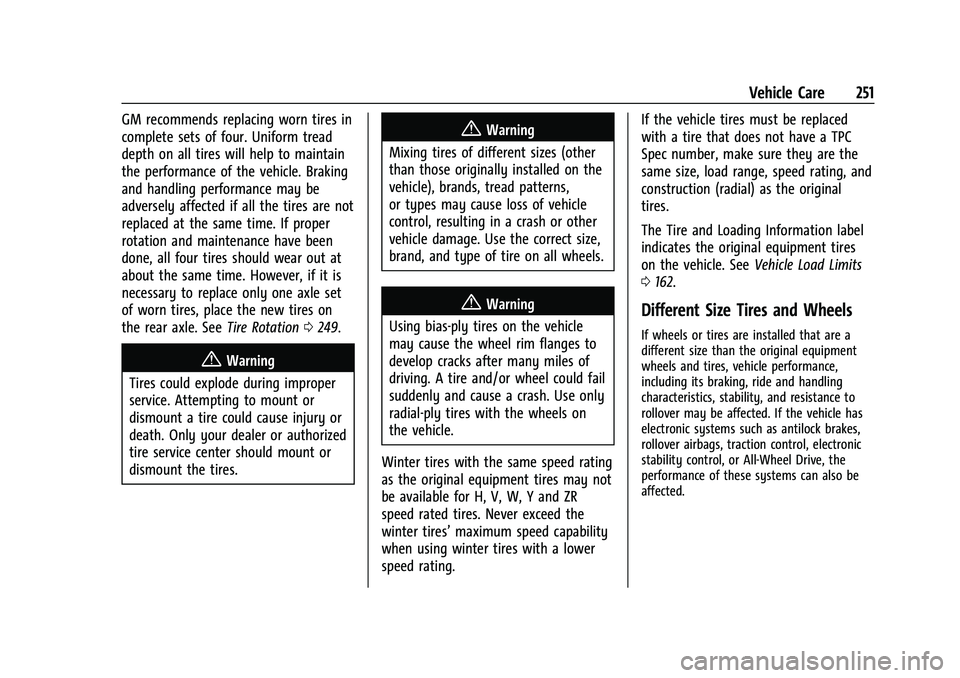
Chevrolet BOLT EV Owner Manual (GMNA-Localizing-U.S./Canada-
15082216) - 2022 - CRC - 6/25/21
Vehicle Care 251
GM recommends replacing worn tires in
complete sets of four. Uniform tread
depth on all tires will help to maintain
the performance of the vehicle. Braking
and handling performance may be
adversely affected if all the tires are not
replaced at the same time. If proper
rotation and maintenance have been
done, all four tires should wear out at
about the same time. However, if it is
necessary to replace only one axle set
of worn tires, place the new tires on
the rear axle. SeeTire Rotation0249.
{Warning
Tires could explode during improper
service. Attempting to mount or
dismount a tire could cause injury or
death. Only your dealer or authorized
tire service center should mount or
dismount the tires.
{Warning
Mixing tires of different sizes (other
than those originally installed on the
vehicle), brands, tread patterns,
or types may cause loss of vehicle
control, resulting in a crash or other
vehicle damage. Use the correct size,
brand, and type of tire on all wheels.
{Warning
Using bias-ply tires on the vehicle
may cause the wheel rim flanges to
develop cracks after many miles of
driving. A tire and/or wheel could fail
suddenly and cause a crash. Use only
radial-ply tires with the wheels on
the vehicle.
Winter tires with the same speed rating
as the original equipment tires may not
be available for H, V, W, Y and ZR
speed rated tires. Never exceed the
winter tires’ maximum speed capability
when using winter tires with a lower
speed rating. If the vehicle tires must be replaced
with a tire that does not have a TPC
Spec number, make sure they are the
same size, load range, speed rating, and
construction (radial) as the original
tires.
The Tire and Loading Information label
indicates the original equipment tires
on the vehicle. See
Vehicle Load Limits
0 162.Different Size Tires and Wheels
If wheels or tires are installed that are a
different size than the original equipment
wheels and tires, vehicle performance,
including its braking, ride and handling
characteristics, stability, and resistance to
rollover may be affected. If the vehicle has
electronic systems such as antilock brakes,
rollover airbags, traction control, electronic
stability control, or All-Wheel Drive, the
performance of these systems can also be
affected.
Page 253 of 316
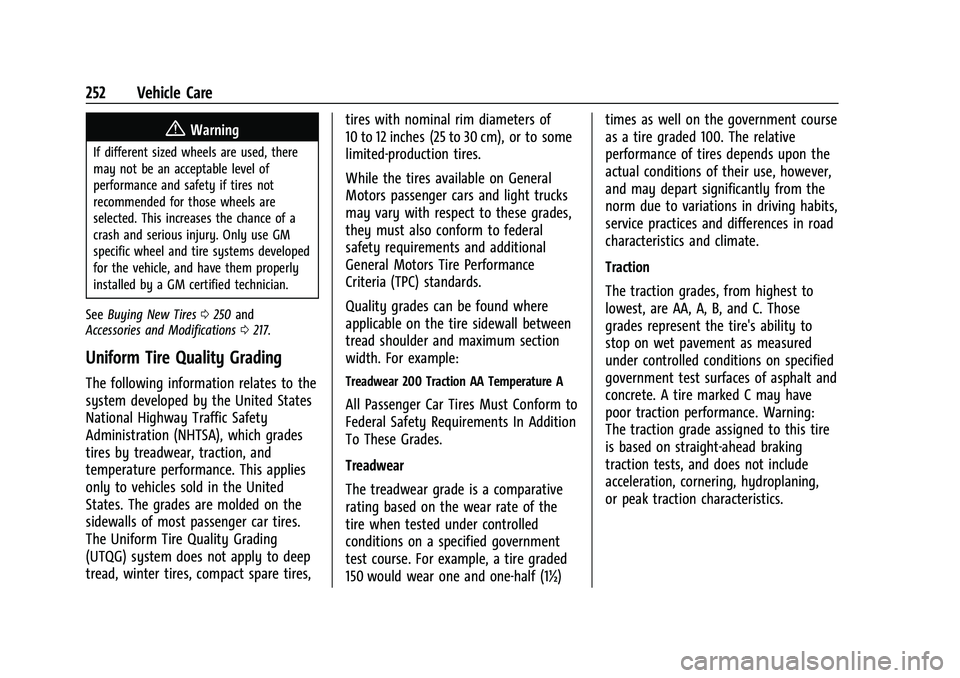
Chevrolet BOLT EV Owner Manual (GMNA-Localizing-U.S./Canada-
15082216) - 2022 - CRC - 6/25/21
252 Vehicle Care
{Warning
If different sized wheels are used, there
may not be an acceptable level of
performance and safety if tires not
recommended for those wheels are
selected. This increases the chance of a
crash and serious injury. Only use GM
specific wheel and tire systems developed
for the vehicle, and have them properly
installed by a GM certified technician.
See Buying New Tires 0250 and
Accessories and Modifications 0217.
Uniform Tire Quality Grading
The following information relates to the
system developed by the United States
National Highway Traffic Safety
Administration (NHTSA), which grades
tires by treadwear, traction, and
temperature performance. This applies
only to vehicles sold in the United
States. The grades are molded on the
sidewalls of most passenger car tires.
The Uniform Tire Quality Grading
(UTQG) system does not apply to deep
tread, winter tires, compact spare tires, tires with nominal rim diameters of
10 to 12 inches (25 to 30 cm), or to some
limited-production tires.
While the tires available on General
Motors passenger cars and light trucks
may vary with respect to these grades,
they must also conform to federal
safety requirements and additional
General Motors Tire Performance
Criteria (TPC) standards.
Quality grades can be found where
applicable on the tire sidewall between
tread shoulder and maximum section
width. For example:Treadwear 200 Traction AA Temperature A
All Passenger Car Tires Must Conform to
Federal Safety Requirements In Addition
To These Grades.
Treadwear
The treadwear grade is a comparative
rating based on the wear rate of the
tire when tested under controlled
conditions on a specified government
test course. For example, a tire graded
150 would wear one and one-half (1½)times as well on the government course
as a tire graded 100. The relative
performance of tires depends upon the
actual conditions of their use, however,
and may depart significantly from the
norm due to variations in driving habits,
service practices and differences in road
characteristics and climate.
Traction
The traction grades, from highest to
lowest, are AA, A, B, and C. Those
grades represent the tire's ability to
stop on wet pavement as measured
under controlled conditions on specified
government test surfaces of asphalt and
concrete. A tire marked C may have
poor traction performance. Warning:
The traction grade assigned to this tire
is based on straight-ahead braking
traction tests, and does not include
acceleration, cornering, hydroplaning,
or peak traction characteristics.
Page 291 of 316
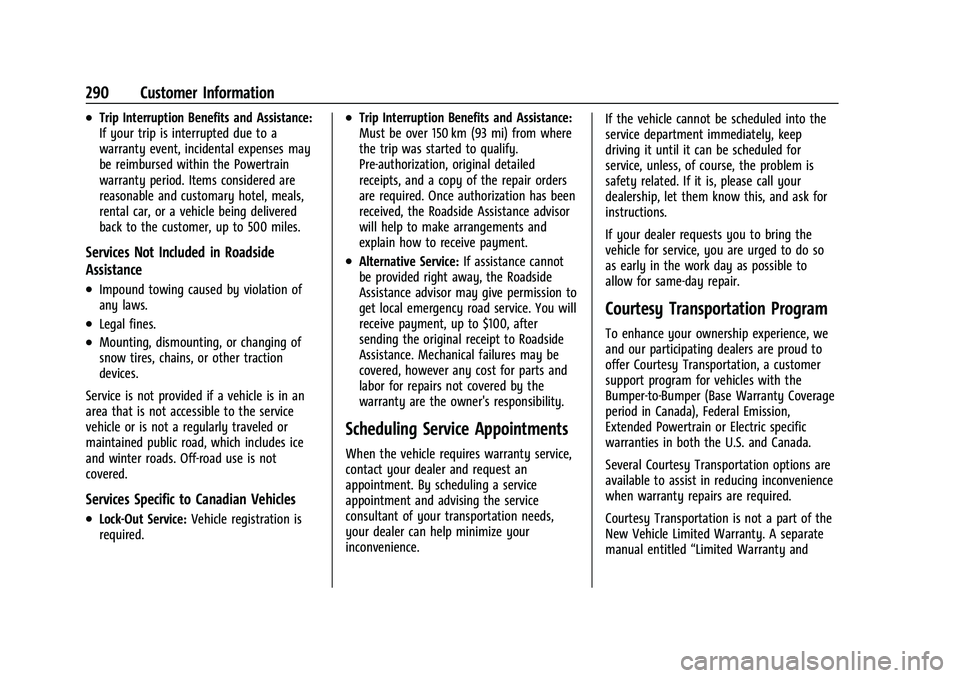
Chevrolet BOLT EV Owner Manual (GMNA-Localizing-U.S./Canada-
15082216) - 2022 - CRC - 6/25/21
290 Customer Information
.Trip Interruption Benefits and Assistance:
If your trip is interrupted due to a
warranty event, incidental expenses may
be reimbursed within the Powertrain
warranty period. Items considered are
reasonable and customary hotel, meals,
rental car, or a vehicle being delivered
back to the customer, up to 500 miles.
Services Not Included in Roadside
Assistance
.Impound towing caused by violation of
any laws.
.Legal fines.
.Mounting, dismounting, or changing of
snow tires, chains, or other traction
devices.
Service is not provided if a vehicle is in an
area that is not accessible to the service
vehicle or is not a regularly traveled or
maintained public road, which includes ice
and winter roads. Off-road use is not
covered.
Services Specific to Canadian Vehicles
.Lock-Out Service: Vehicle registration is
required.
.Trip Interruption Benefits and Assistance:
Must be over 150 km (93 mi) from where
the trip was started to qualify.
Pre-authorization, original detailed
receipts, and a copy of the repair orders
are required. Once authorization has been
received, the Roadside Assistance advisor
will help to make arrangements and
explain how to receive payment.
.Alternative Service: If assistance cannot
be provided right away, the Roadside
Assistance advisor may give permission to
get local emergency road service. You will
receive payment, up to $100, after
sending the original receipt to Roadside
Assistance. Mechanical failures may be
covered, however any cost for parts and
labor for repairs not covered by the
warranty are the owner's responsibility.
Scheduling Service Appointments
When the vehicle requires warranty service,
contact your dealer and request an
appointment. By scheduling a service
appointment and advising the service
consultant of your transportation needs,
your dealer can help minimize your
inconvenience. If the vehicle cannot be scheduled into the
service department immediately, keep
driving it until it can be scheduled for
service, unless, of course, the problem is
safety related. If it is, please call your
dealership, let them know this, and ask for
instructions.
If your dealer requests you to bring the
vehicle for service, you are urged to do so
as early in the work day as possible to
allow for same-day repair.
Courtesy Transportation Program
To enhance your ownership experience, we
and our participating dealers are proud to
offer Courtesy Transportation, a customer
support program for vehicles with the
Bumper-to-Bumper (Base Warranty Coverage
period in Canada), Federal Emission,
Extended Powertrain or Electric specific
warranties in both the U.S. and Canada.
Several Courtesy Transportation options are
available to assist in reducing inconvenience
when warranty repairs are required.
Courtesy Transportation is not a part of the
New Vehicle Limited Warranty. A separate
manual entitled
“Limited Warranty and
Page 307 of 316
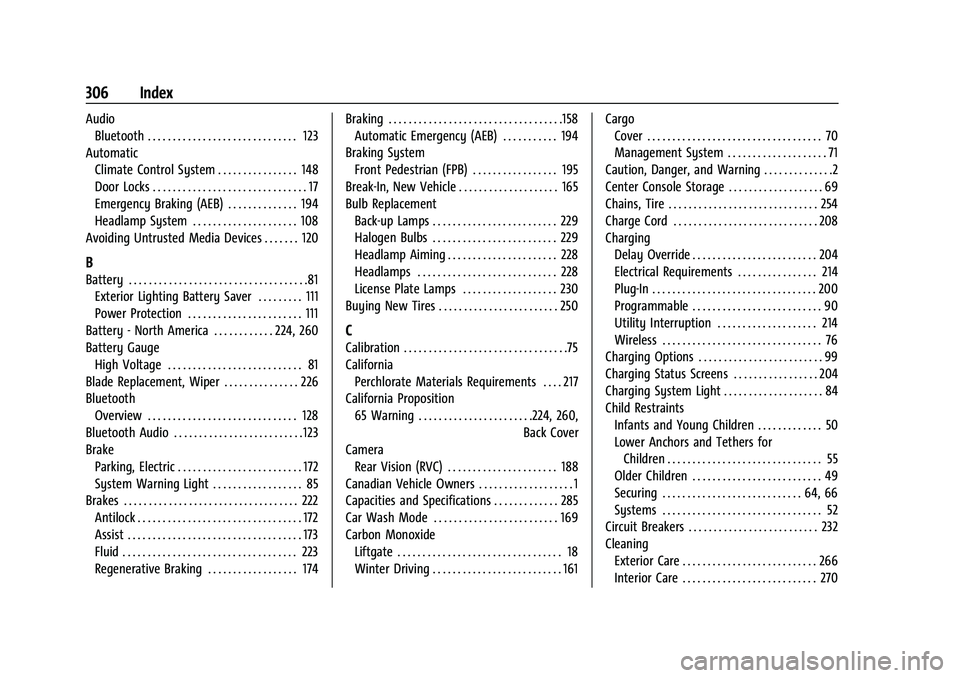
Chevrolet BOLT EV Owner Manual (GMNA-Localizing-U.S./Canada-
15082216) - 2022 - CRC - 6/25/21
306 Index
AudioBluetooth . . . . . . . . . . . . . . . . . . . . . . . . . . . . . . 123
Automatic Climate Control System . . . . . . . . . . . . . . . . 148
Door Locks . . . . . . . . . . . . . . . . . . . . . . . . . . . . . . . 17
Emergency Braking (AEB) . . . . . . . . . . . . . . 194
Headlamp System . . . . . . . . . . . . . . . . . . . . . 108
Avoiding Untrusted Media Devices . . . . . . . 120
B
Battery . . . . . . . . . . . . . . . . . . . . . . . . . . . . . . . . . . . .81 Exterior Lighting Battery Saver . . . . . . . . . 111
Power Protection . . . . . . . . . . . . . . . . . . . . . . . 111
Battery - North America . . . . . . . . . . . . 224, 260
Battery Gauge High Voltage . . . . . . . . . . . . . . . . . . . . . . . . . . . 81
Blade Replacement, Wiper . . . . . . . . . . . . . . . 226
Bluetooth
Overview . . . . . . . . . . . . . . . . . . . . . . . . . . . . . . 128
Bluetooth Audio . . . . . . . . . . . . . . . . . . . . . . . . . . 123
Brake Parking, Electric . . . . . . . . . . . . . . . . . . . . . . . . . 172
System Warning Light . . . . . . . . . . . . . . . . . . 85
Brakes . . . . . . . . . . . . . . . . . . . . . . . . . . . . . . . . . . . 222 Antilock . . . . . . . . . . . . . . . . . . . . . . . . . . . . . . . . . 172
Assist . . . . . . . . . . . . . . . . . . . . . . . . . . . . . . . . . . . 173
Fluid . . . . . . . . . . . . . . . . . . . . . . . . . . . . . . . . . . . 223
Regenerative Braking . . . . . . . . . . . . . . . . . . 174 Braking . . . . . . . . . . . . . . . . . . . . . . . . . . . . . . . . . . .158
Automatic Emergency (AEB) . . . . . . . . . . . 194
Braking System Front Pedestrian (FPB) . . . . . . . . . . . . . . . . . 195
Break-In, New Vehicle . . . . . . . . . . . . . . . . . . . . 165
Bulb Replacement Back-up Lamps . . . . . . . . . . . . . . . . . . . . . . . . . 229
Halogen Bulbs . . . . . . . . . . . . . . . . . . . . . . . . . 229
Headlamp Aiming . . . . . . . . . . . . . . . . . . . . . . 228
Headlamps . . . . . . . . . . . . . . . . . . . . . . . . . . . . 228
License Plate Lamps . . . . . . . . . . . . . . . . . . . 230
Buying New Tires . . . . . . . . . . . . . . . . . . . . . . . . 250
C
Calibration . . . . . . . . . . . . . . . . . . . . . . . . . . . . . . . . .75
California Perchlorate Materials Requirements . . . . 217
California Proposition 65 Warning . . . . . . . . . . . . . . . . . . . . . . .224, 260, Back Cover
Camera
Rear Vision (RVC) . . . . . . . . . . . . . . . . . . . . . . 188
Canadian Vehicle Owners . . . . . . . . . . . . . . . . . . . 1
Capacities and Specifications . . . . . . . . . . . . . 285
Car Wash Mode . . . . . . . . . . . . . . . . . . . . . . . . . 169
Carbon Monoxide Liftgate . . . . . . . . . . . . . . . . . . . . . . . . . . . . . . . . . 18
Winter Driving . . . . . . . . . . . . . . . . . . . . . . . . . . 161 Cargo
Cover . . . . . . . . . . . . . . . . . . . . . . . . . . . . . . . . . . . 70
Management System . . . . . . . . . . . . . . . . . . . . 71
Caution, Danger, and Warning . . . . . . . . . . . . . .2
Center Console Storage . . . . . . . . . . . . . . . . . . . 69
Chains, Tire . . . . . . . . . . . . . . . . . . . . . . . . . . . . . . 254
Charge Cord . . . . . . . . . . . . . . . . . . . . . . . . . . . . . 208
Charging Delay Override . . . . . . . . . . . . . . . . . . . . . . . . . 204
Electrical Requirements . . . . . . . . . . . . . . . . 214
Plug-In . . . . . . . . . . . . . . . . . . . . . . . . . . . . . . . . . 200
Programmable . . . . . . . . . . . . . . . . . . . . . . . . . . 90
Utility Interruption . . . . . . . . . . . . . . . . . . . . 214
Wireless . . . . . . . . . . . . . . . . . . . . . . . . . . . . . . . . 76
Charging Options . . . . . . . . . . . . . . . . . . . . . . . . . 99
Charging Status Screens . . . . . . . . . . . . . . . . . 204
Charging System Light . . . . . . . . . . . . . . . . . . . . 84
Child Restraints Infants and Young Children . . . . . . . . . . . . . 50
Lower Anchors and Tethers forChildren . . . . . . . . . . . . . . . . . . . . . . . . . . . . . . . 55
Older Children . . . . . . . . . . . . . . . . . . . . . . . . . . 49
Securing . . . . . . . . . . . . . . . . . . . . . . . . . . . . 64, 66
Systems . . . . . . . . . . . . . . . . . . . . . . . . . . . . . . . . 52
Circuit Breakers . . . . . . . . . . . . . . . . . . . . . . . . . . 232
Cleaning
Exterior Care . . . . . . . . . . . . . . . . . . . . . . . . . . . 266
Interior Care . . . . . . . . . . . . . . . . . . . . . . . . . . . 270